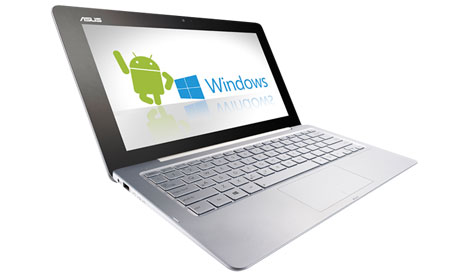
Asus Transformer Book Trio: runs both Windows 8 and Android
Desperation makes strange bedfellows.
The advent of
hybrid devices running both Windows 8 and Android is a painful reminder of what OEMs think of both Windows RT and
Windows 8 as tablet OSs.
Two of the major PC vendors (Samsung
and Asus) have now released hybrid devices that run
Android in tablet mode and Windows 8 in laptop mode. This takes "Windroid" from what looks like a silly experiment and changes it into an earnest attempt to address some of the shortcomings of Windows 8.
The ability to pin Android
apps onto the Windows 8 start screen is a clear sign that the real problem with Windows 8 is the availability of apps for its "Metro" mode.
Microsoft will proudly tout a number in the region of 100,000 for apps available for Windows 8 this week at its Build conference but the cool, new and cutting edge apps never seem to be available.
This problem could also have been solved by running an Android emulator on the device – so the choice of a full Android implementation points to other issues in addition to app availability. It strongly implies that the OEMs also do not see Windows 8 as a good user experience for a tablet which is a huge problem for Microsoft.
The whole point of Windows 8 is its flexibility and ability to provide a great user experience in both Metro and desktop modes, but if no one is interested then one may as well stick with the excellent Windows 7.
In desktop mode there is not much to separate the Windows 7 and Windows 8 experiences.
I have long held the opinion that Microsoft has done an incredibly bad job at telling users why they should buy Windows 8.
However, I am not expecting much traction as hybrid OS devices have been tried before and have been show to be very niche with low volumes.
Furthermore, the devices are very heavy for tablets, and the inability to share data between the two modes is likely to substantially limit their appeal.
These devices (and the new Samsung ATIV Tab 3) are also a damning indictment of Windows RT, where manufacturer support has dropped virtually to zero.
The best that I can hope from Windows RT is that it is folded into Windows 8, and devices on the ARM architecture begin to appear where the only choice the user has to make is based on performance, battery life and price. Its persistence as a shadow of Windows 8 confuses users and makes them less willing to join the Windows 8 ecosystem.
If Microsoft can make strides towards informing users how they can live their Digital Lives with Microsoft and solve the confusion around Windows RT then it becomes a very compelling proposition. However, while its biggest OEM partners feel that they have to include Android to make a viable hybrid device, one can tell that something is seriously wrong.
A version of this post first appeared on Richard Windsor's Radio Free Mobile site.















0 comments :